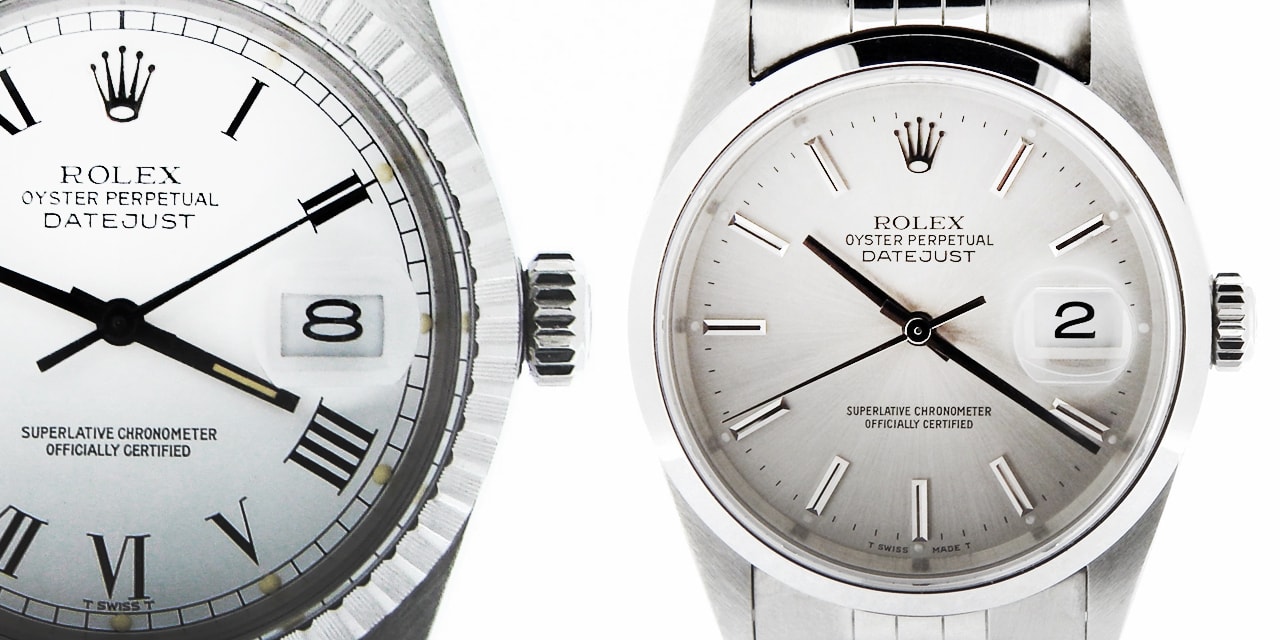Stainless Steel Rolex Datejust Compare: 16000, 16014, 16030 vs. 16200, 16234, 16220
When buying a stainless steel Rolex Datejust from the secondary market, you’re faced with an abundance of models and styles to comb through. Given the evolution of the Datejust model over its more than 70-year history, it can be a difficult task to figure out what exactly are the differences and similarities between one generation to the next. So, to make sense of it all, we compare stainless steel Datejust 160xx vs 162xx models to cover over two eras of evolution.
The Shared Design Details
Prior to digging into the specifics of each model, let’s highlight the commonalities between these stainless steel Datejust watches, irrespective of when they were made. They all have 36mm Oyster cases built with a water depth rating of 100 meters. Furthermore, they all (naturally) include the date aperture at 3 o’clock after which the watch is named, in addition to the Cyclops lens above it charged to magnify the date. Finally, all steel Datejust watches are of course equipped with automatic mechanical movements.
Design: Stainless Steel Rolex Datejust 16000 vs. 16200; 16014 vs. 16234; 16030 vs. 16220
The stainless steel Rolex Datejust ref. 16000 and ref. 16200 have steel smooth bezels, the ref. 16014 and ref. 16024 have white gold fluted bezels, and the ref. 16030 and the ref. 16220 have steel engine-turned bezels.
Ref. 160xx
There are no two generations of steel Datejust watches that differ in design as dramatically as the ref. 160xx models and the ref. 162xx models. Rolex manufactured the older of the two families (ref. 16000, 16014, and 16030) from the late 1970s until the late 1980s. These particular steel Datejust watches have all the elements you would expect from a vintage Rolex watch from their acrylic crystals to their tritium lume to their holes in the lugs of the cases. Also, there’s a choice of Oyster or Jubilee bracelets, all featuring flip clasps, hollow links, and end pieces.
Ref. 162xx
On the other hand, the newer editions of the stainless steel Datejust watches (ref. 16200, 16234, and 16220) were produced from the late 1980s until the mid 2000s and ushered in some modern design details such as scratch-resistant sapphire crystal protecting the dials. Furthermore, in the mid 1990s, Rolex phased out the lug holes from their cases, so early models of the Datejust ref. 162xx watches had lug holes, while those that came after the mid-1990s no longer had them.
Luminova to SuperLuminova
What’s more, during the production period of these Datejust watches, Rolex also introduced the Luminova luminescent material in the late 1990s, followed by SuperLuminova a few years later. So depending on when they were made, the steel Datejust ref. 162xx watches can come with any of the three different types of lume material. The bracelets, however, remained the same with the newer Datejust watches—also with a choice of Oyster or Jubilee, and all with flip clasps and hollow links.
Movement: Stainless Steel Rolex Datejust 16000 vs. 16200; 16014 vs. 16234; 16030 vs. 16220
The steel Datejust 16000, 16014, and 16030 run on Caliber 3035 while the steel Datejust 16200, 16234, and 16220 include Caliber 3135. Both are automatic movements with the quickset date function—meaning that the date is set independently from the center timekeeping hands.
Performance wise, the Caliber 3135 offers improvements in accuracy, durability, and a longer power reserve of 48 hours compared to the previous 42 hours. Practicality wise, it’s interesting to note that to set the time with the Caliber 3035, the crown is turned counterclockwise, while with the Caliber 3135 the crown is turned clockwise to adjust the time.
To conclude, if you’re looking for a steel Datejust watch that offers vintage style but comes with the practicality of a quickset movement, then the ref. 160xx models will have what you want. Alternatively, if you’d prefer a more contemporary steel Datejust watch with modern features like sapphire crystal, then the 162xx would be better suited for you.
— Featured Photo and Body Photo Credits: BeckerTime’s Archive.






